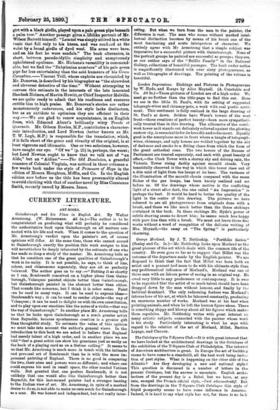CURRENT LITERATURE.
ART•BOOKS.
Gainsborough and his Place in English Art. By Walter Armstrong. (W. Heinemann. J85 5s.)—The author is to be congratulated on producing what will probably be considered the authoritative book upon Gainsborough on all matters con- nected with his life and work. When it comes to the question of Mr. Armstrong's verdict upon the painter's art, of course opinions will differ. At the same time, those who cannot accord to Gainsborough exactly the position this work assigns to him will nevertheless be deeply interested by the estimate of one who has made so deep a study of the master. Mr. Armstrong tells us that he considers one of the great qualities of Gainsborough's work is its unity. It is not possible, he says, to think of line, colour, and chiaroscuro separately, they- are all so perfectly balanced. The author goes on to say :—" Putting it as shortly as I can, Rembrandt conceived on a higher plane than Gains- borough, Velasquez painted objects better than Gainsborough, but Gainsborough painted in the abstract better than either. That sounds like nonsense, but I think it is sober sense. Paint an be used in many ways. It can be used to express ideas- Rembrandt's way ; it can he used to render objects—the way of Velasquez ; it can be used to delight us with its own constitution, and to play upon our emotions like the notes of a violin—that was the way of Gainsborough." In another place Mr. Armstrong tells us that he looks upon Gainsborough as a much greater artist than Reynolds, because spontaneous creation is a greater gift than thoughtful study. To estimate the value of this opinion we must take into account the author's general views. In the introduction to this book we are asked to believe that Raphael had merely talent of a high order, and in another place we are told " that a great artist can show his greatness just as easily on the back of a playing card as on a Sistine ceiling." It seems to us that Mr. Armstrong is much more in touch with the intimate and personal art of Rembrandt than he is with the more im- personal painting of Raphael. There is no good in comparing the two, their aims and powers were so different; and where one could express his soul in small space, the other needed Vatican walls. But granted that one prefers Rembrandt, it is not unlikely that one would also like Gainsborough better than Reynolds, for this last-named painter had a stronger leaning to the Italian view of art. Mr. Armstrong, in spite of a marked desire to do so, is not able to make us care much for Gainsborough as a man. He was honest and independent, but not really inter-
eating. But when we turn from the man to the painter, the difference is vast. The man who seems without marked intel- lectual distinction becomes by means of his brush one of the most fascinating and acute interpreters of character. We entirely agree with Mr Armstrong that a simple subject was imperative for a successful picture with Gainsborough. None of the portrait groups he painted are successful as groups ; they are, as our author says of the " Baillie Family" in the National Gallery, collections of beautiful passages. The book under notice is magnificently illustrated with over sixty photogravures, as well as lithographs of drawings. The printing of the volume is beautiful.






































 Previous page
Previous page